|
Hot air is widely used in all kinds of manufacturing processes but when it comes to specifying an air heater they are not all interchangeable. There are several types of air heaters available and the best type for a particular application depends on a number of factors. This article outlines the differences between high and low flow heaters and gives tips on when and how to use each type correctly.
How are High Flow and Low Flow Heaters alike?
Both types of heaters are categorized as in-line heaters. This means that air is heated by passing over a heating element as it passes through the heater travelling from the inlet to the outlet. In most cases the air is supplied by an industrial blower but it can also be supplied by an air compressor.
How are High Flow and Low Flow Heaters different?
The fundamental difference in these two types of heaters is in the design of the heating element. A low flow heater uses a fully supported element where a coil made from resistance wire is supported by winding it through a ceramic structure. You’ll see in Figure 1 below that the ceramic structure looks like a honeycomb. A high flow heater uses an open coil element as shown in Figure 2. The element coil is largely exposed supported only around the circumference of the heater.
Impact of Element Configuration
Element configuration impacts the amount of pressure drop across the heater. The low flow heater with its fully supported element offers much more resistance, constraining the air flow and causing a much higher pressure drop than the open coil element in the high flow heater. The additional support provided to the heating element filament in a low flow heater, along with the different ceramic materials used, allow for the low flow heater to operate at higher temperatures than the high flow heater. Low flow heaters usually have maximum operating temperatures in the range of 650°C to 800°C. The high flow heaters have a lower maximum operating temperature, usually around 450°C.
Low Flow or High Flow for my Application?
If your application requires large volumes of heated air below 450°C, a high flow heater is the right choice. If your applications requires higher temperatures and lower air flow then a low flow heater is the best bet. Of course there is overlap and there will be applications where both types will work at which point secondary considerations come into play.
A Note on Blowers
The type of heater chosen impacts the type of blower that is typically used. Often a regenerative blower is chosen over a centrifugal blower for low flow heaters since they operate at pressures high enough to overcome the pressure drop across the heaters’ element. Centrifugal blowers can work however low flow heaters, however the designer should consider whether they will achieve sufficient flow through the heater if a centrifugal blower is chosen.
Since high flow heaters are often used where large volumes of air are required, it follows that they are often used with centrifugal blowers. Their low pressure drop allows the air to flow through the heater freely. While this is generally the case, other considerations may make a regenerative blower a better fit for your application. Most heater manufacturers can give you specifications on the pressure drop of their heater to help you make the correct choice and ensure you blower is sized correctly for your application. See our article on Regenerative versus Centrifugal Blowers for more information about the differences and similarities between these two types of blower. At STANMECH we are experts in processes involving hot air. Please call us if you would like to discuss your application. Comments are closed.
|
|
STANMECH Technologies Inc.
944 Zelco Drive Burlington ON L7L 4Y3 | 1-888-438-6324 | [email protected] Terms of Use Privacy Terms and Conditions of Sale Warranty Policies |
|
Proud Member of:



